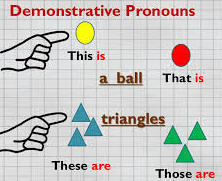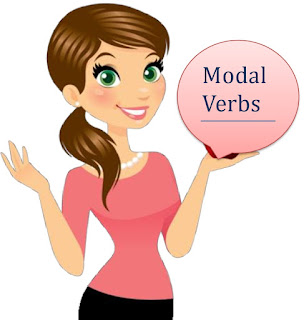Lesson Plan of Demonstrative Pronoun English Grade IV
Lesson Plan of Demonstrative Pronoun
English Grade IV
Students’ Learning Outcomes
·
Illustrate the use of words
that point to something.
Information for Teachers
·
A demonstrative pronoun is a
word that takes the place of particular objects or people:
(Examples: this, these, that,
those, here, there)
·
The pronoun “this” is used to
refer to a singular object which is near the speaker (or here).
(Example: This is a broken
glass)
·
The pronoun “that” is used to
refer to a singular object which is far from the speaker or something from the
past (or there)
(Example: That is a huge
building. That picnic was great.(last year)
·
The pronoun “these” is used
to refer to more than one object (plural) which is near the speaker. (or here)
(Example: These are my crayons).
·
The pronoun “those” is used
to refer to more than one object (plural) which are far from the speaker or in
the past (or there).
(Example: Those girls are
looking pretty. Those were very cold days).
·
Demonstrative pronouns should
be taught and practiced using the actions.
Material / Resources
Chalk/marker, board, textbook
Worm up activity
·
Hold a book in your hand and
ask the whole class: What
is this? Place stress on “this”.
·
The students might give a one
word answer, “book”. Ask the students to answer in a complete sentence: This is
a book.
·
Point out to the object
placed far (Example: a table, chair, wall, fan) and ask: What is that? Place
stress on “that”. Tell the students to answer in a sentence.
·
Ask the students: if someone
or something is placed close to your, which word used to point out to it; this
or that? If someone or something is placed at a distance from you, which word
is used to point to it; this or that?
·
Encourage the students with
words like “Good” or “well done” if they give correct answers. Teach them the
rule to use the demonstrative pronouns “this” and “that” if they give incorrect
answers.
·
Explain them that just like
we use the words ‘ye’ and “woh”. We use the words ‘this’ and ‘that’ in English
to point towards things, near or far from us.
·
Ask the students: if there
are many people or things placed near you, which word is used to point to them;
these or those? If there are many people or things placed far from you, which
word is used to point to them; these or those? Explain to the students that
although same words are used in Urdu to point towards singular and plural
things (Different words used in English to point towards singular and plural
things.
·
Encourage the students with
words like “Good” or “Well done” if they give correct answers. Teach them the
rule to use the demonstrative pronouns “these” and “those” with actions and
examples if they give incorrect answers.
·
You can also help students
understand the use of demonstrative pronouns by using simple line drawings. For
example.
·
Draw these simple drawings on
the board and ask the children why this, that, these, and those are being used
in the above sentences.
·
Now draw the following table
on the board and ask the students to copy it in their notebooks.
Placement of Object
|
Singular
|
Plural
|
Near
|
This
|
These
|
Far
|
That
|
Those
|
Development
Activity 1
·
Write 5 sentences on the
board.
·
Ask the students to choose
one demonstrative pronoun from the brackets to complete each sentence.
·
Help the students understand
the meaning of each sentence.
·
The sentence will give them
clues as to which demonstrative pronoun is to be used.
Activity 2
·
Write on the board: Pen
·
Ask the students: What is the
gender of the pen? Is it masculine, feminine or neuter?
·
After the students have given
the answer, ask them: Which pronoun is used for neuter gender?
·
Depending upon the students’
previous correct or incorrect answers, you can give them options of pronouns:
Which pronoun is used for neuter gender; he, she, it?
·
After the students have given
the answer, write on the board: it is my pen.
·
Tell the students that it is
used for singular neuter nouns.
·
Write 8-10 neuter gender
nouns on the board.
·
Ask students to make
sentences using the nouns with the pronoun ‘it’ as subject, e.g. it is a book. It
is my bag.
·
Repeat the instructions if
necessary. Provide support where necessary.
Sum up / Conclusion
·
Quickly review the lesson by asking
the students questions:
1.
Which pronoun is used for
people and things close to us?
2.
Which pronoun is used for people
and things far from us?
3.
Is “this” a singular or plural?
Is “those” a singular or plural?
4.
Is the pronoun “it” used for
singular nouns or plural nouns? Etc.
Assessment
·
Assess students’
understanding of demonstrative pronouns through their correct responses during
worm up activity and sum up.
·
Assess students’ ability to
illustrate use of demonstrative pronouns through the correct choices made
during the activity 1.
·
Assess students’ ability to
construct short sentences with the pronoun “it” as subject through their
performance in the activity 2.
·
Assess students’ ability to
illustrate use of the pronoun ‘it’ as subject through their performance in the
follow up activity.
·
Assess students’
understanding by making your own test.
Follow up
·
Write 5 sentences on the
board for students to copy in their notebooks. Ask them to rewrite the
sentences by replacing the nouns with the pronoun “it”. Noun must be the
subjects of the sentences.
Sample Sentences Activity:
1.
_______ watch on my wrist says it is 4pm. (These, This)
2.
Can you eat ______________
biscuits on the table? (Those, That)
3.
_____________ plants are growing very fast.
(These, This)
4.
___________
book on my desk is not mine. (These, This)
5.
__________ is your lost key. (That, Those)
6.
____________ cat has got one
leg broken. (That, Those)





HELLO GET OUT OF FINANCIAL MESS WITH THE HELP OF drbenjaminfinance@gmail.com
ReplyDeleteI have been in financial mess for the past months, I’m a single mum with kids to look after. My name is REBECCA MICHAELSON, and am from Ridley Park, Pennsylvania. A couple of weeks ago My friend visited me and along our discussion she told me about DR BENJAMIN OWEN FINANCE of (drbenjaminfinance@gmail.com); that he can help me out of my financial situation, I never believed cause I have spend so much money on different loan lenders who did nothing other than running away with my money. She advised, I gave it a try because she and some of her colleagues were rescued too by this Godsent lender with loans to revive their dying businesses and paying off bills. so I mailed him and explain all about my financial situation and therefore took me through the loan process which was very brief and easy. After that my loan application worth $278,000.00USD was granted, all i did was to follow the processing and be cooperative and today I am a proud business owner sharing the testimony of God-sent Lender. You can as well reach him through the Company WhatsApp +19292227023 Email drbenjaminfinance@gmail.com
THANK YOU VERY MUCH